Japanese perspective
> Aur0ra
> Research project
- war recounts
- gojira
- nuclear 'allergy'
"Before the events of Gojira!"
70 years after Hiroshima, victims' children still worry about health. Nakatani Etsuko says her father rarely spoke of the day that the world’s first atomic weapon killed 140,000 people in his city of Hiroshima, Japan.
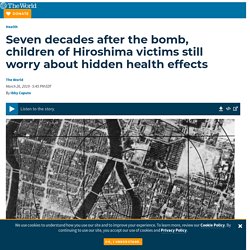
But she says he did mention one thing: “That there were so many dead bodies in the river, you couldn’t see the water.”
Atomic Heritage Foundation. On March 1, 1954, the United States carried out its largest nuclear detonation, “Castle Bravo,” at Bikini Atoll in the Marshall Islands.

The Bravo shot was the first test of Operation Castle, a series of thermonuclear tests. The explosion was more than two and a half times greater than expected and caused far higher levels of fallout and damage than scientists had predicted. The Bravo test used a device called “Shrimp,” which relied on lithium deuteride as its fuel.
U.S. film tells story of Japanese boat exposed to 1954 nuclear test. For many Americans, the story of the Japanese fishing crew that was exposed to a U.S. hydrogen bomb test in the Pacific Ocean 65 years ago may be a footnote in history easy to overlook.
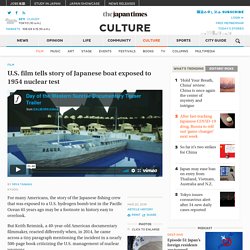
But Keith Reimink, a 40-year-old American documentary filmmaker, reacted differently when, in 2014, he came across a tiny paragraph mentioning the incident in a nearly 500-page book criticizing the U.S. management of nuclear weapons.
Review: Deleuze, Japanese Cinema, and the Atom Bomb. Originally published in 2014, David Deamer‘s monograph Deleuze, Japanese Cinema, and the Atom Bomb: The Spectre of Impossibility came out in a paperback reprint earlier this year and ultimately found its way also into my reading pile.
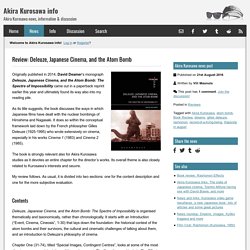
As its title suggests, the book discusses the ways in which Japanese films have dealt with the nuclear bombings of Hiroshima and Nagasaki. It does so within the conceptual framework laid down by the French philosopher Gilles Deleuze (1925-1995) who wrote extensively on cinema, especially in his works Cinema 1 (1983) and Cinema 2 (1985). The book is strongly relevant also for Akira Kurosawa studies as it devotes an entire chapter for the director’s works. Its overall theme is also closely related to Kurosawa’s interests and oeuvre. My review follows.
MOFA: Testimony of Hibakusha (atomic bomb survivors)
Japan, as the only country which has ever suffered atomic bombings, continues to actively support its atomic bomb survivors, the Hibakusha, to share their stories with the people of the world.
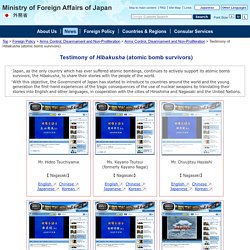
With this objective, the Government of Japan has started to introduce to countries around the world and the young generation the first-hand experiences of the tragic consequences of the use of nuclear weapons by translating their stories into English and other languages, in cooperation with the cities of Hiroshima and Nagasaki and the United Nations. Mr. Hideo Tsuchiyama 【Nagasaki】 Ms. Kayano Tsutsui (formerly Kayano Nagai) 【Nagasaki】 Mr.
Chuujitsu Hayashi 【Nagasaki】 Mr. Contact details for enquiries about using these testimonies Director of Nagasaki National Peace Memorial Hall for the Atomic Bomb Victims 7-8 Hirano-machi, Nagasaki City 852-8117, Japan TEL: +81(0)95-814-0055 FAX: +81(0)95-814-0056 E-mail: info@peace-nagasaki.go.jp Application Form [PDF] 使用申請依頼書(英語)(Word) 使用申請依頼書(英語)(PDF)
70 years after Hiroshima, victims' children still worry about health. Japan marks 70 years since US dropped atomic bomb on Nagasaki during WWII. The Japanese city of Nagasaki has marked 70 years since the US dropped an atomic bomb.
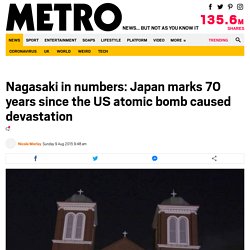
A ceremony was held at the Nagasaki Peace Park, where people paid their respects by observing a minute’s silence. Today is exactly 70 years since the U.S. atomic bombing on August 9, 1945, three days after the first atomic bomb was dropped on Hiroshima.
U.S. film tells story of Japanese boat exposed to 1954 nuclear test. Grave of the Fireflies (short story)
Grave of the Fireflies (火垂るの墓, Hotaru no Haka) is a 1967 semi-autobiographical short story by Japanese author Akiyuki Nosaka.
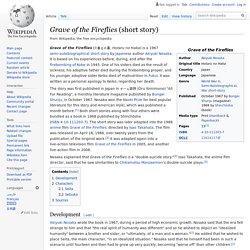
It is based on his experiences before, during, and after the firebombing of Kobe in 1945. One of his sisters died as the result of sickness, his adoptive father died during the firebombing proper, and his younger adoptive sister Keiko died of malnutrition in Fukui. It was written as a personal apology to Keiko, regarding her death.
CBBC Newsround: Hiroshima - A survivor's story in animation. Hiroshima and two paradoxes of Japanese nuclear perplexity: Critical Military Studies: Vol 1, No 2. Wittgenstein, “grammar”, and political metaphor In Philosophical Investigations, Wittgenstein asserts that discourse or “grammar” is “the shadow of possibility cast by language on phenomena” (Wittgenstein 1958Wittgenstein, L. 1958.
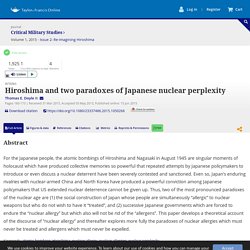
Philosophical Investigations. 3rd ed. Translated by G. E. M. How can a human being with any claim to a sense of moral responsibility deliberately let loose an instrument of destruction which can at one stroke annihilate an appalling segment of mankind? To say that atomic or nuclear warfare is nihilistic and “strikes at the heart of moral existence” is to discursively construct the possibility of the annihilation of moral value (along with that of humanity) and then to proscribe that annihilation.
- info. Cineosis - the tablature of Deleuze's sign system, the explication of definitions and cinematic examples (cineosis blog) - are the work of David Deamer.
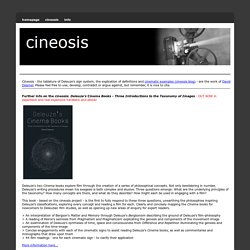
Please feel free to use, develop, contradict or argue against, but remember, it is nice to cite. Further info on the cineosis: Deleuze's Cinema Books - Three Introductions to the Taxonomy of Images - OUT NOW in paperback and real expensive hardback and ebook! Deleuze's two Cinema books explore film through the creation of a series of philosophical concepts. Not only bewildering in number, Deleuze's writing procedures mean his exegesis is both complex and elusive.









